Backside Line
If you need barefoot-style mountaineering boots for three-season mountaineering with glorious traction, the Vivobarefoot Tracker Forest ESC is for you. It’s the one zero-drop boot on our finest mountaineering boots for males information due to its excellent pure really feel, strong traction, and burly design. Senior gear analyst Ian Krammer has examined these over 150 miles and 10+ days of mountaineering within the Colorado Rockies. He put them via their paces on and off path, the place they provided glorious flexibility and noteworthy floor really feel.
Due to a large toe field and zero-drop design, your ft are in a position to unfold out and flex naturally, serving to you keep a relaxed and ergonomic gait. The large 7 mm lugs present dependable traction on most surfaces, though the only depth stays skinny and versatile. So skinny, in truth, that the footwear can really be rolled up right into a small package deal for storage on and off path. We like these for his or her sturdiness and elegance, too – the wild-hide leather-based uppers are powerful sufficient for wilderness adventures however trendy sufficient for the suburbs.
Nonetheless, the Tracker Forest ESC isn’t the perfect match for everybody. This can be a actually minimalist barefoot boot: they characteristic a zero-drop design, nearly no arch help, and a really large toe field for pure flexion. In different phrases, in case you’re in search of basic construction and help in a mountaineering boot, you might wish to look elsewhere. They’re additionally impressively water-proof, however meaning they’re on the heavy aspect for barefoot boots, which could not work properly for light-weight hikers and backpackers. Lastly, the only depth is skinny, which makes them much less sturdy total in comparison with burlier boots.
These are additionally a number of the priciest boots we’ve examined – though you received’t discover higher high quality or safety within the barefoot boot class. When you’re in search of versatile, cozy zero-drop footwear for cooler temperatures and need pure motion over most help and safety, the Forest ESCs are a terrific selection.
Fast Specs
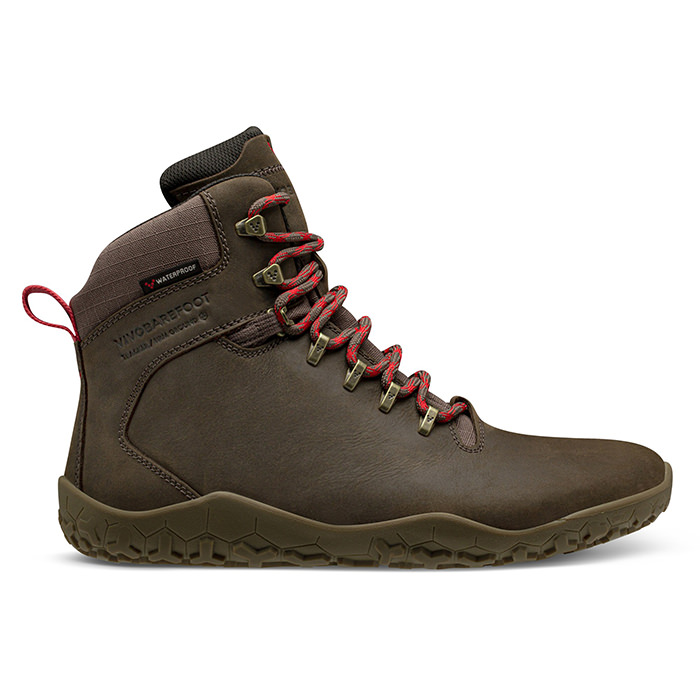
Males’s Vivobarefoot Tracker Forest ESC
Greatest Zero-Drop Climbing Boots
CleverHiker Score:
71.3/100
Worth:
$270
Weight (Pair):
2 lb. 4.8 oz.
Higher Materials:
leather-based
Sizing:
Common width
Execs
- Pure foot form
- Big toe field
- Barefoot really feel
- Nice traction
- Sneakers might be folded small
- Versatile ankles
- Good climate resistance
Cons
- Heavy for barefoot boots
- Outsole much less sturdy
- Zero-drop footwear aren’t for everybody
- Costly
- Gradual to dry
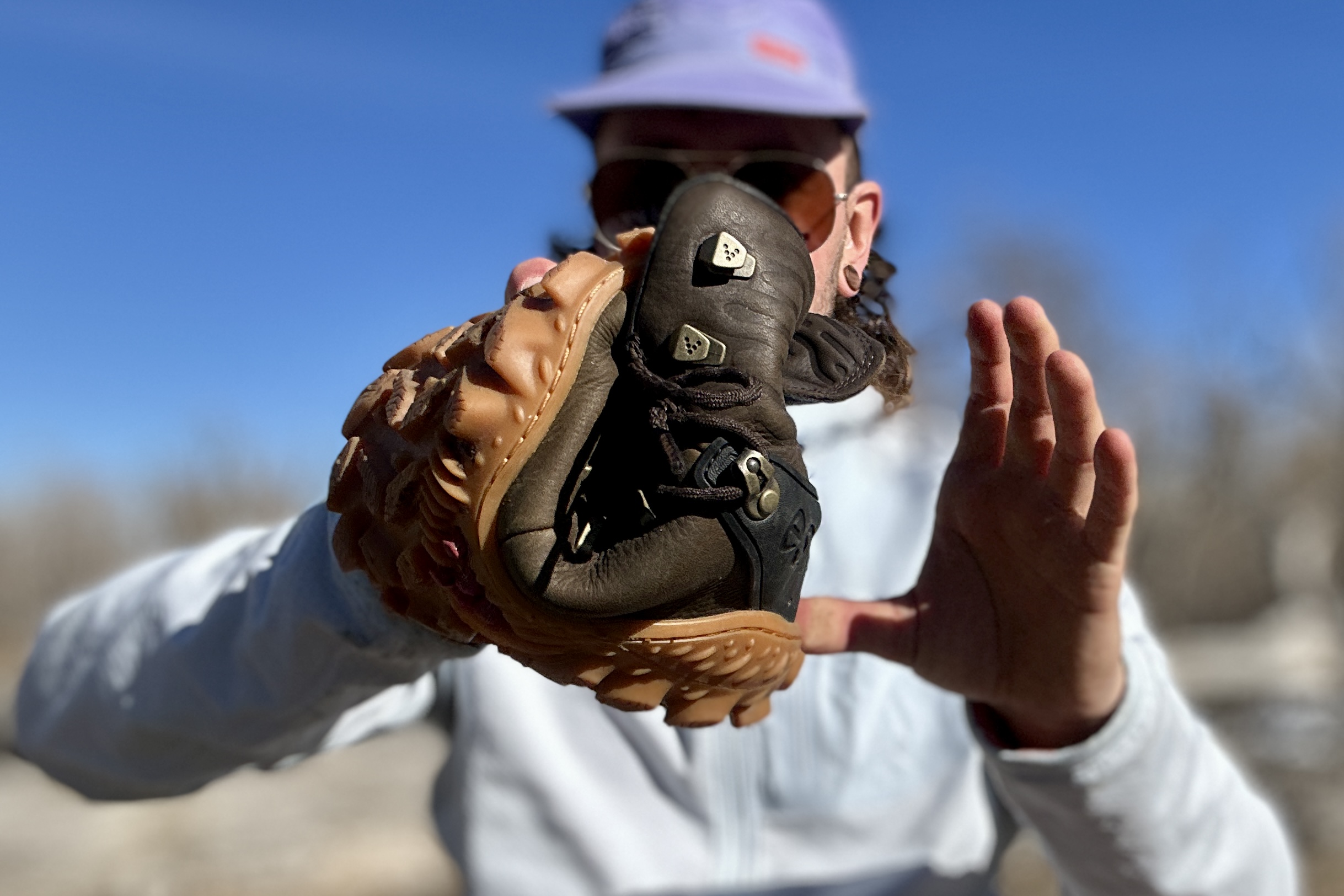
Consolation
For barefoot hikers taking over diverse terrain, the Vivobarefoot Tracker Forest ESC is one among our prime picks. Not like conventional footwear, zero-drop boots don’t have any heel-to-toe top distinction. Which means your ft can bend, flex and unfold naturally in these boots – as if you’re barefoot – to maintain your stride impartial over lengthy miles. When you’re out there for zero-drop boots, these are within the candy spot for a foot-shaped profile, versatile soles, and malleable uppers.
We additionally love the large toe field in these boots. This design permits toes to unfold out naturally and the foot to flex uninhibited, which is necessary on off-camber trails and rocky routes. Due to the ultra-thin 2.5 mm sole depth and really minimal arch help, you’ll discover most rocks and roots within the Forest ESC, making for excellent sensitivity to the bottom that extra structured boots lack. We additionally discover them simple to placed on and take off due to the softer supplies and huge heel loop.
Gear analyst Ian Krammer discovered that after simply 10 miles of mountaineering, the wild disguise leather-based and rubber paneling adapts properly to your ft for a versatile and comfy match, which makes them a terrific choice for various foot sizes and styles. And as soon as the laces are dialed in, they maintain stress throughout the highest of the ft properly, and wish minimal changes.
On the draw back, the Forest ESCs design isn’t for everybody. When you desire extra safety from the bottom or added help via the foot, the skinny soles and lack of construction can really feel uncomfortable. And, in case you’re used to extra conventional boots with a excessive heel-to-toe drop, switching to zero-drop footwear can take a number of weeks to regulate.
Throughout testing on scorching summer time days in Rocky Mountain Nationwide Park, we discovered the leather-based can really feel too scorching above 80°F. At these temperatures, our ft had been sweating, which might result in blisters and rubbing on longer hikes. The lacing system is a bit cumbersome: the three lace hook pairs on the prime of the boot curve inward, which catches the laces as an alternative of letting them slide simply. Usually, it takes a bit extra focus and time to tie the Forest ESC, which isn’t supreme whenever you’re in a rush or must make a fast adjustment.

Ankle Assist
If you need minimal ankle help, these are the boots for you. Their wild disguise leather-based and rubber overlays present a sturdy however versatile higher for agile, pure ankle movement in comparison with conventional mountaineering boots. The taller ankle top provides waterproofing and a little bit of safety in brambles and overgrowth, but it surely’s greater than mushy sufficient to maintain a pure gait. Plus, Vivobarefoot’s wild disguise leather-based will get softer and extra pliable the extra you put on it, making these a terrific match for various foot shapes and mountaineering wants.
We advocate the Forest ESC on nearly any terrain the place groundfeel issues. We’ve taken these on critical off-trail terrain like rocky scrambles and thick bushwhacks in Colorado’s Entrance Vary, the place we needed to really feel the form of the rocks, the curve of a log, and angle of the bottom as we moved. When exact foot placement issues, otherwise you merely like a extra versatile boot, these are a terrific selection.
Nonetheless, these boots lack the agency ankle help present in bulkier, conventional mountaineering fashions. When you like inflexible boots, particularly boots with ankle help for heavy hundreds or rugged situations, you’ll wish to look elsewhere. Hikers with weak or injury-prone ankles could discover the minimalist design underwhelming, particularly on steep inclines and routes with combined terrain. Their zero-drop platform additionally shifts extra stabilization work to the ankles, which might instantly result in pressure on longer or intense hikes.
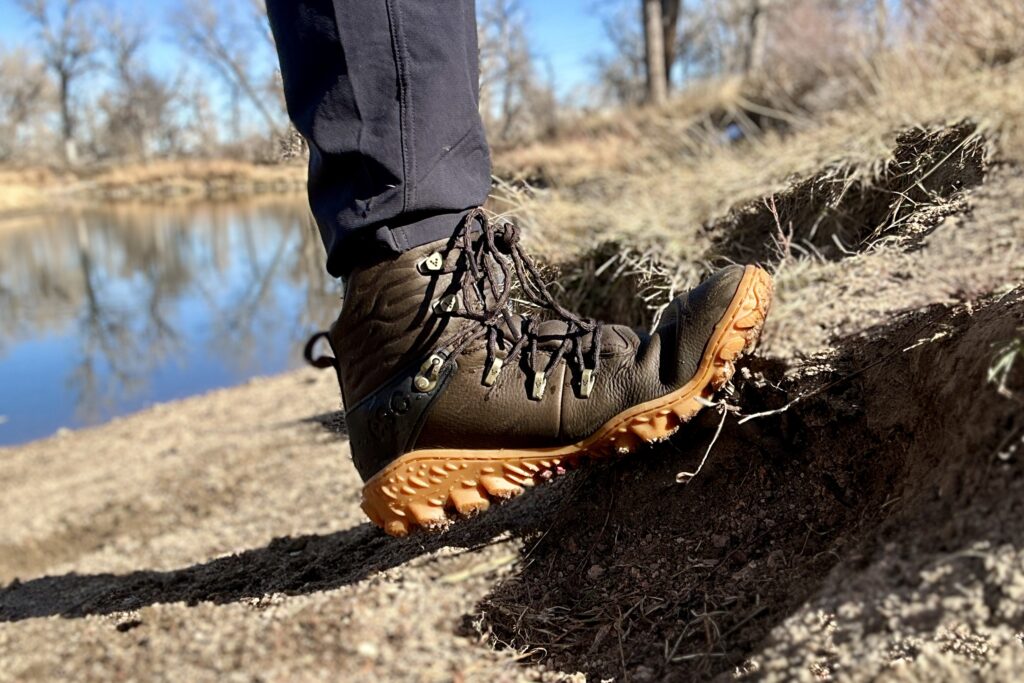
Weight
If you need minimal ankle help, these are the boots for you. Their wild disguise leather-based and rubber overlays present a sturdy however versatile higher for agile, pure ankle movement in comparison with conventional mountaineering boots. The taller ankle top provides waterproofing and a little bit of safety in brambles and overgrowth, but it surely’s greater than mushy sufficient to maintain a pure gait. Plus, Vivobarefoot’s wild disguise leather-based will get softer and extra pliable the extra you put on it, making these a terrific match for various foot shapes and mountaineering wants.
We advocate the Forest ESC on nearly any terrain the place groundfeel issues. We’ve taken these on critical off-trail terrain like rocky scrambles and thick bushwhacks in Colorado’s Entrance Vary, the place we needed to really feel the form of the rocks, the curve of a log, and angle of the bottom as we moved. When exact foot placement issues, otherwise you merely like a extra versatile boot, these are a terrific selection.
Nonetheless, these boots lack the agency ankle help present in bulkier, conventional mountaineering fashions. When you like inflexible boots, particularly boots with ankle help for heavy hundreds or rugged situations, you’ll wish to look elsewhere. Hikers with weak or injury-prone ankles could discover the minimalist design underwhelming, particularly on steep inclines and routes with combined terrain. Their zero-drop platform additionally shifts extra stabilization work to the ankles, which might instantly result in pressure on longer or intense hikes. .
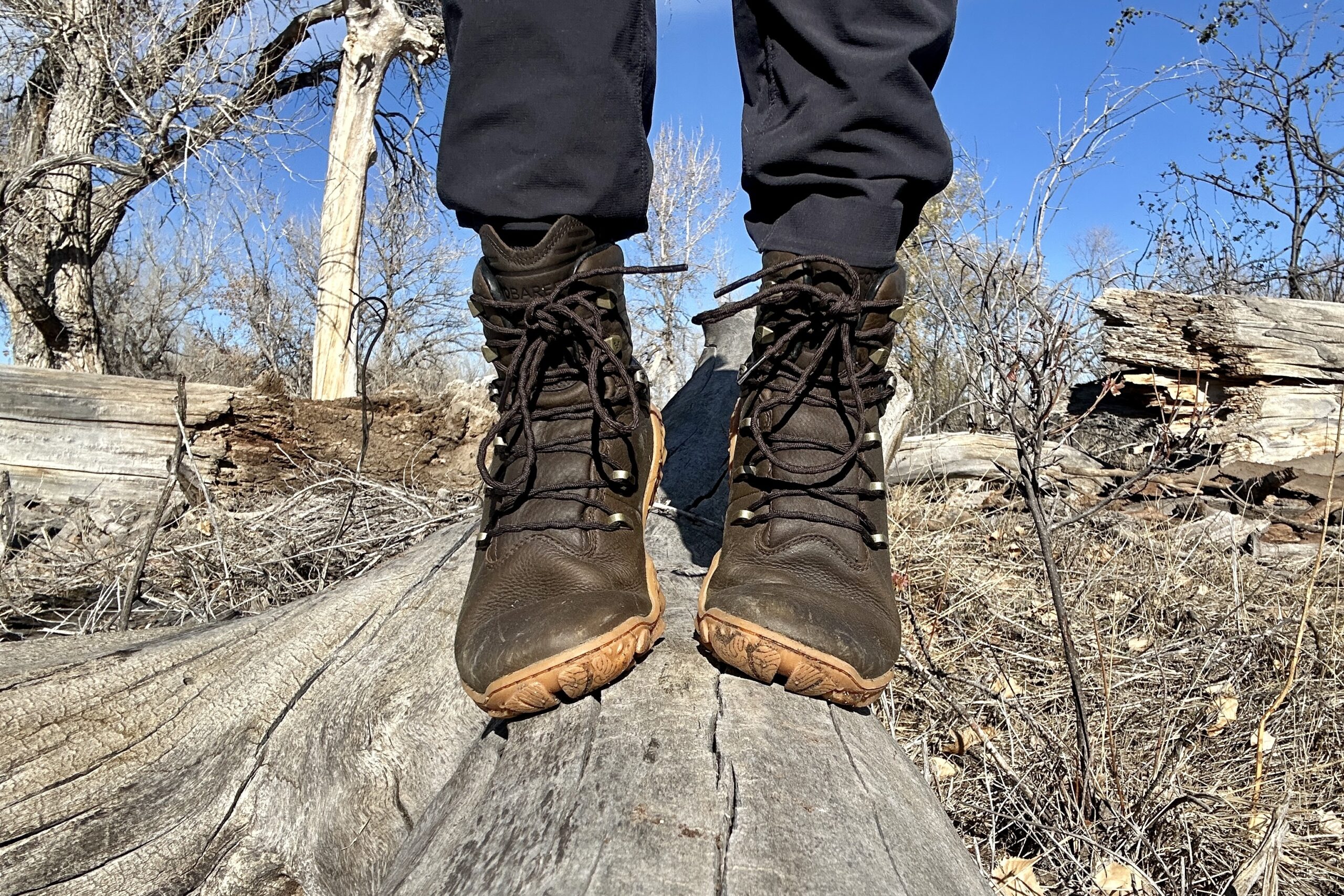
Traction
The Vivobarefoot Tracker Forest ESCs have dependable traction due to skinny, sticky rubber outsoles with large lugs that supply glorious floor really feel. The only depth is barely 2.5 mm, which suggests you’ll expertise the lumps and bumps of the path greater than most mountaineering boots. When cautious foot placement is essential, otherwise you merely need most floor contact with each step, these are a terrific selection. Their Michelin model outsoles are tremendous versatile and preserve fixed contact with the bottom whenever you’re heading off-trail and wish dependable traction on difficult, forested inclines and rocky routes.
Their lug depth is a whopping 7 mm, a number of the deepest lugs we’ve seen within the mountaineering boot class. Which means the Forest ESC feels extremely safe on ascents and descents. On a climb of Colorado’s 13,154’ Ogallala Peak in summer time, we discovered this design was particularly efficient for traction on unfastened, dry terrain like gravel, dust, and sand. It additionally carried out properly on brief, technical sections the place sensitivity to edges was necessary. The lug design is unfold out sufficient that it sheds mud simply, too. When you’re clamoring up sharp inclines and braking on gnarly downhills, these kicks deal with tough trails like an SUV in low gear.
The draw back? These are minimalist boots with much less padding than conventional choices. We seen the shortage of cushioning most on flat, groomed trails and human-made surfaces, the place the skinny soles and deep lugs nonetheless grip properly, however can really feel a bit awkward and knobby. When you desire boots with thicker midsoles produced from foam, or in case you’re mountaineering completely on flat, groomed trails, these boots will miss the mark.
We additionally discover these boots aren’t probably the most dependable on icy, tremendous slick terrain. They had been dependable when crossing moist logs and rocks after rainstorms within the excessive Rockies, however in terms of exhausting surfaces the place the lugs can’t dig in, like moist grass, boulders, and ice, they have an inclination to slip. That mentioned, this was a small situation – in terms of traction, these boots get the job performed.
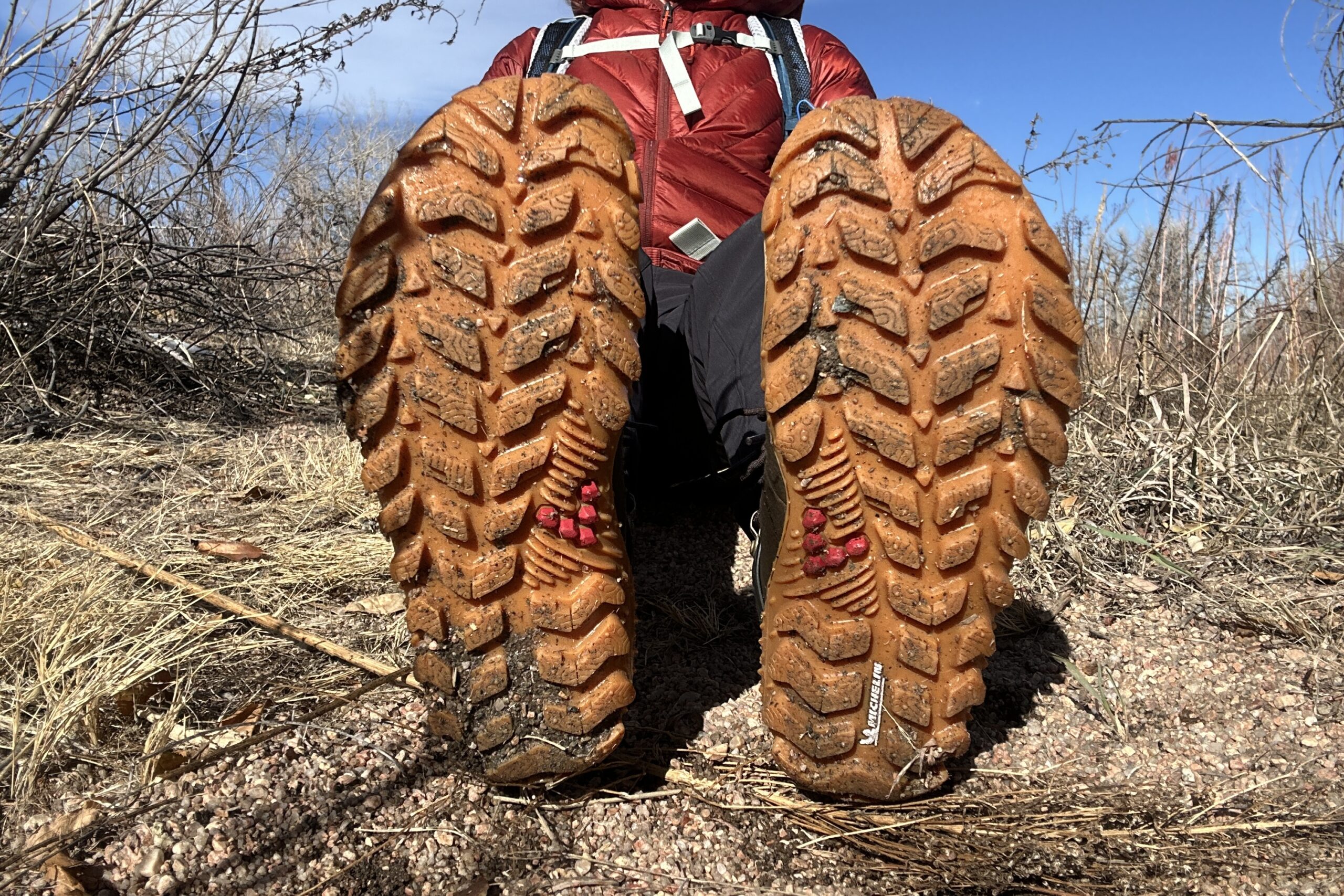
Climate Resistance
The Forest ESCs supply strong climate resistance, in order that they’re a very good decide for mountaineering in early spring till late fall. Their wild disguise leather-based uppers present a protecting layer towards moisture and damp situations that can preserve your ft dry throughout fast storms. A waterproof leather-based construct, mixed with a comfortable ankle collar, helps stop water from seeping in. When Senior Gear Analyst Ian Krammer was crossing shallow streams, puddles, and transferring via moist underbrush throughout testing, he discovered the ankle top and supplies minimized splash-back and stored twigs, gravel, and dirt out.
That mentioned, the Forest ESCs do have some limitations. They’ve a water-proof coating, rubber overlays, and double-stitched outsoles to assist resist moisture – however that’s their main line of protection. They don’t have a water-proof membrane like extra conventional choices. Though we haven’t discovered this to be a problem in our testing up to now, you’ll want to remain on prime of standard waterproofing remedies with leather-based care merchandise to maintain the leather-based performing its finest.
The leather-based additionally supplies a little bit of added heat, making this mannequin a good selection for cool shoulder season situations the place you want a bit of additional insulation with out overheating. These boots felt comfy on frigid 35 to 45°F days within the backcountry. Nonetheless, we don’t advocate them beneath freezing – they don’t have a lot padding in comparison with thicker choices, so that you’ll wish to use heat mountaineering socks when the temperatures dip. On the flipside, you might wish to look elsewhere in case you’re headed into particularly scorching climates. The leather-based isn’t breathable and has no mesh, to allow them to really feel highly regarded in 80°F and above.
One other draw back of those boots is that they dry slowly. Despite the fact that Vivobarefoot claims quick-drying synthetics on the within, we discover the other after we unintentionally dunked our ft in a creek crossing. The Forest ESC took many hours to completely dry at room temperature, and it was an uncomfortable stroll out, which may very well be an actual downside on longer journeys in unpredictable climate.
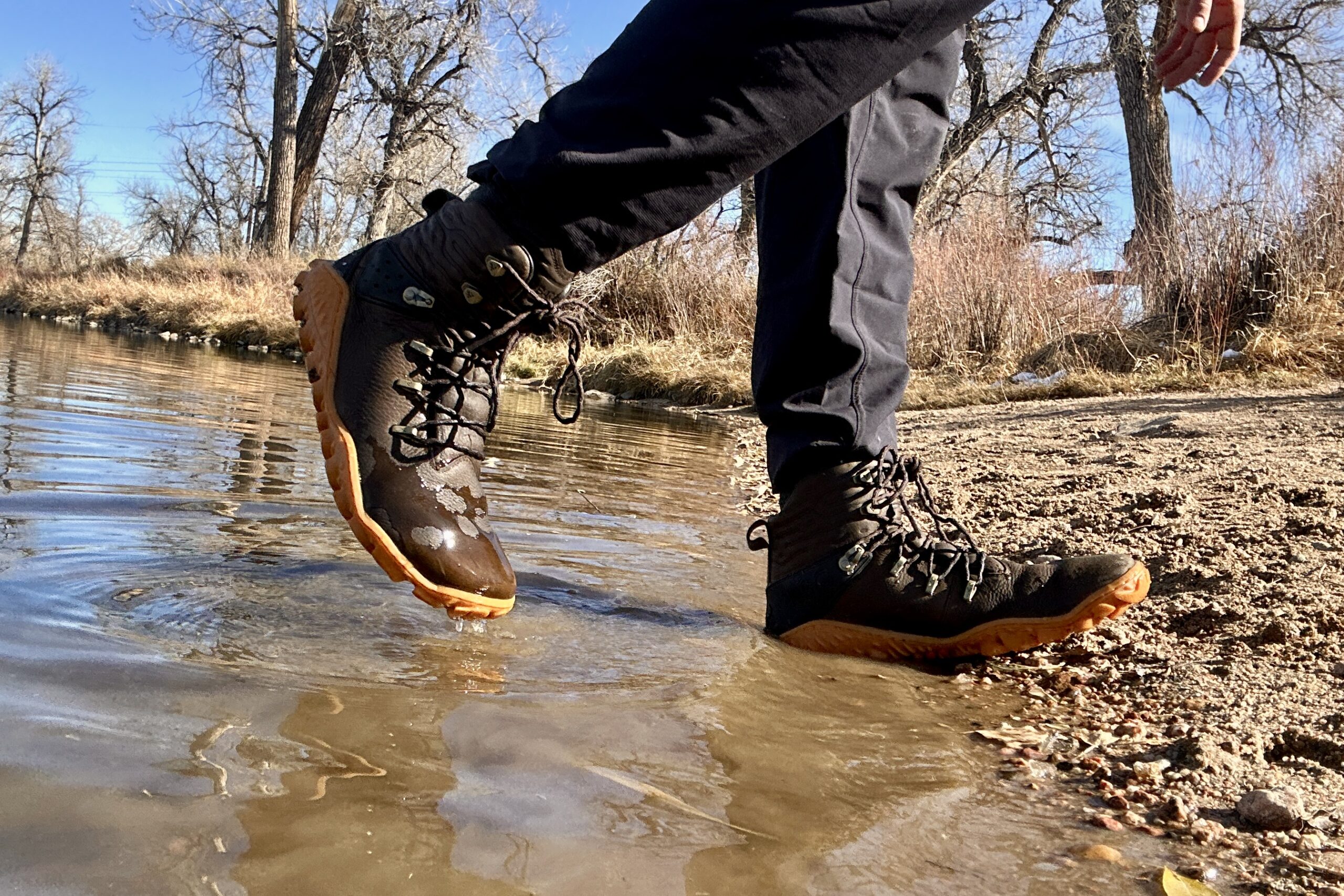
Sturdiness
With sturdy wild disguise leather-based uppers, artificial rubber overlays, and powerful rubber soles, the Forest ESC’s supply strong sturdiness. These supplies are powerful however versatile within the backcountry and successfully resist abrasions from sharp rocks, brambles, and roots whereas protecting the boot’s integrity and form.
Like most leather-based boots, this mannequin requires common upkeep like leather-based cleaner and waterproof remedies to forestall drying and cracking, protect their flexibility, and improve their water resistance. Our testing reveals probably the most vital put on on the uppers happens on the forefoot flex level and throughout the ankle’s higher space. We’ve additionally seen injury to the stitching in the back of the foot, the place the outsole is hooked up to the heel.
Easy steel parts, spherical laces, and a burly heel loop enhance the longevity of the Forest ESCs. The versatile rubber outsole is stitched instantly onto the leather-based of the boots for added sturdiness, decreasing the probabilities of the outsole separating from the uppers. Though the soles are skinny, Vivobarefoot makes use of Michelin’s proprietary rubber composite that balances grip and sturdiness.
Our largest gripe about these boots is the shortage of sturdiness of the outsoles. Total, Vivobarefoot’s rubber mix is sticky and cheesy on most surfaces, however it’s not as long-lasting because the uppers or boots with heavier, thicker, and stiffer composites. We’ve but to check these boots to their level of failure, however primarily based on how the lugs have worn down on the 250 mile mark, we anticipate to get at the least one other 250 miles earlier than the soles put on out. Fortunately, Vivobarefoot companions with Nushoe.com, a resoling service for liked footwear – so when it’s time for a brand new pair, you might have choices.
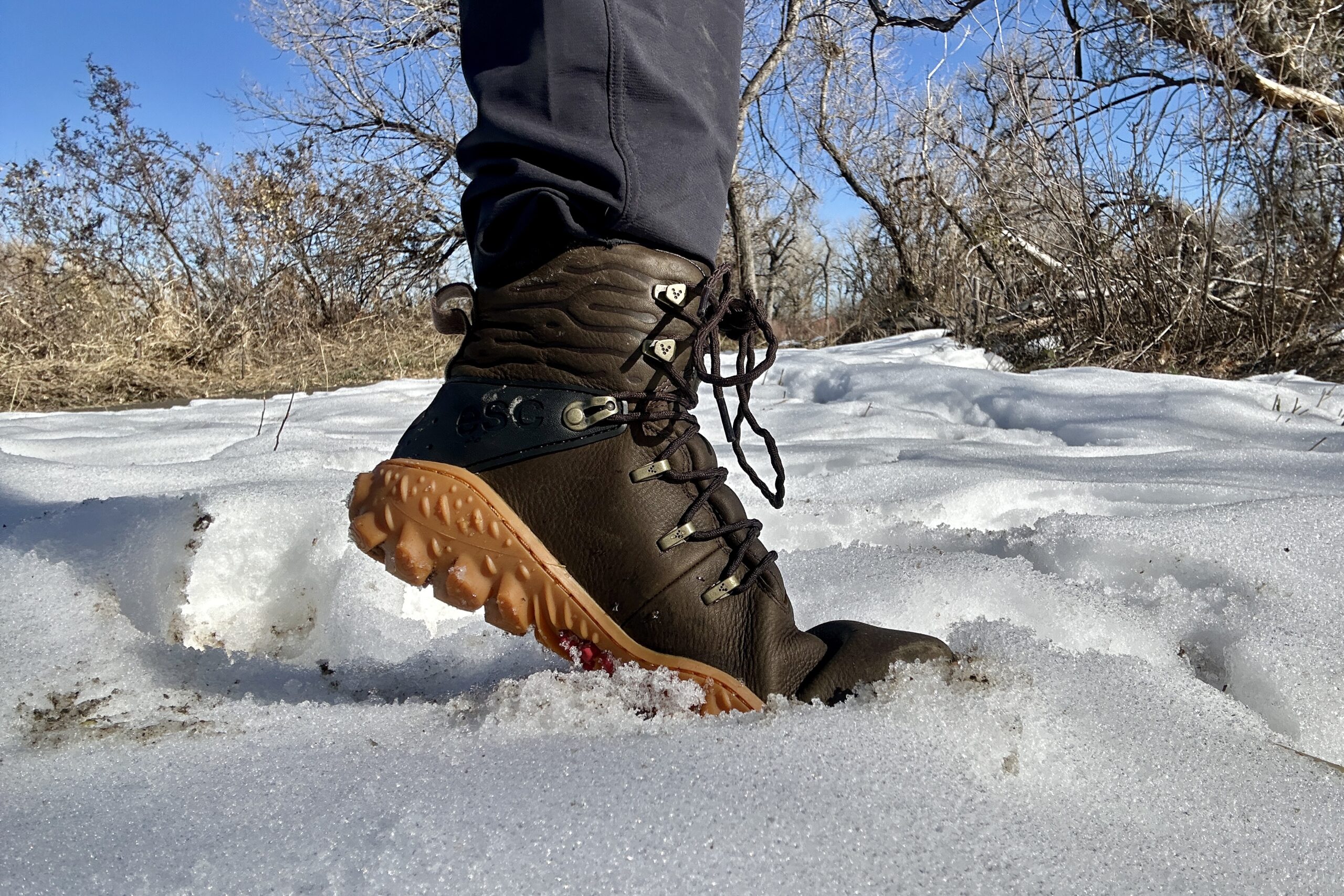
The Vivobarefoot Tracker 2 is a good selection for minimalist hikers who need zero-drop boots with a pure foot form for day hikes and fast adventures in cool and truthful climate. The Tracker 2s have a large toe field, tall ankle and padded tongue that makes them really feel comfy mile after mile – however due to leather-based and rubber uppers, these boots nonetheless supply strong safety from brambles and sharp rocks. Combining deep lugs with a skinny sole depth, the Tracker 2’s really feel gentle however dependable on the whole lot from rocky routes to groomed trails. When you’re in search of a close-to-the-ground mountaineering expertise, the Tracker 2s gives best-in-class floor really feel and suppleness that barefoot hikers will love.
Nonetheless, we don’t advocate the Tracker 2’s for mountaineering completely on easy, flat trails – or in case you’re tackling icy or extraordinarily moist environments, the place the deep lugs aren’t as grippy. The soles aren’t as sturdy as boots constructed with stronger and thicker supplies, and in the event that they do get moist inside, they’ll take a very long time to dry out. Lastly, the ESC is a bit heavy and spendy. Nonetheless, for hikers who need sturdy barefoot-style boots with strong safety, an ergonomic design, and unequalled floor really feel, the Tracker 2’s will verify each field.
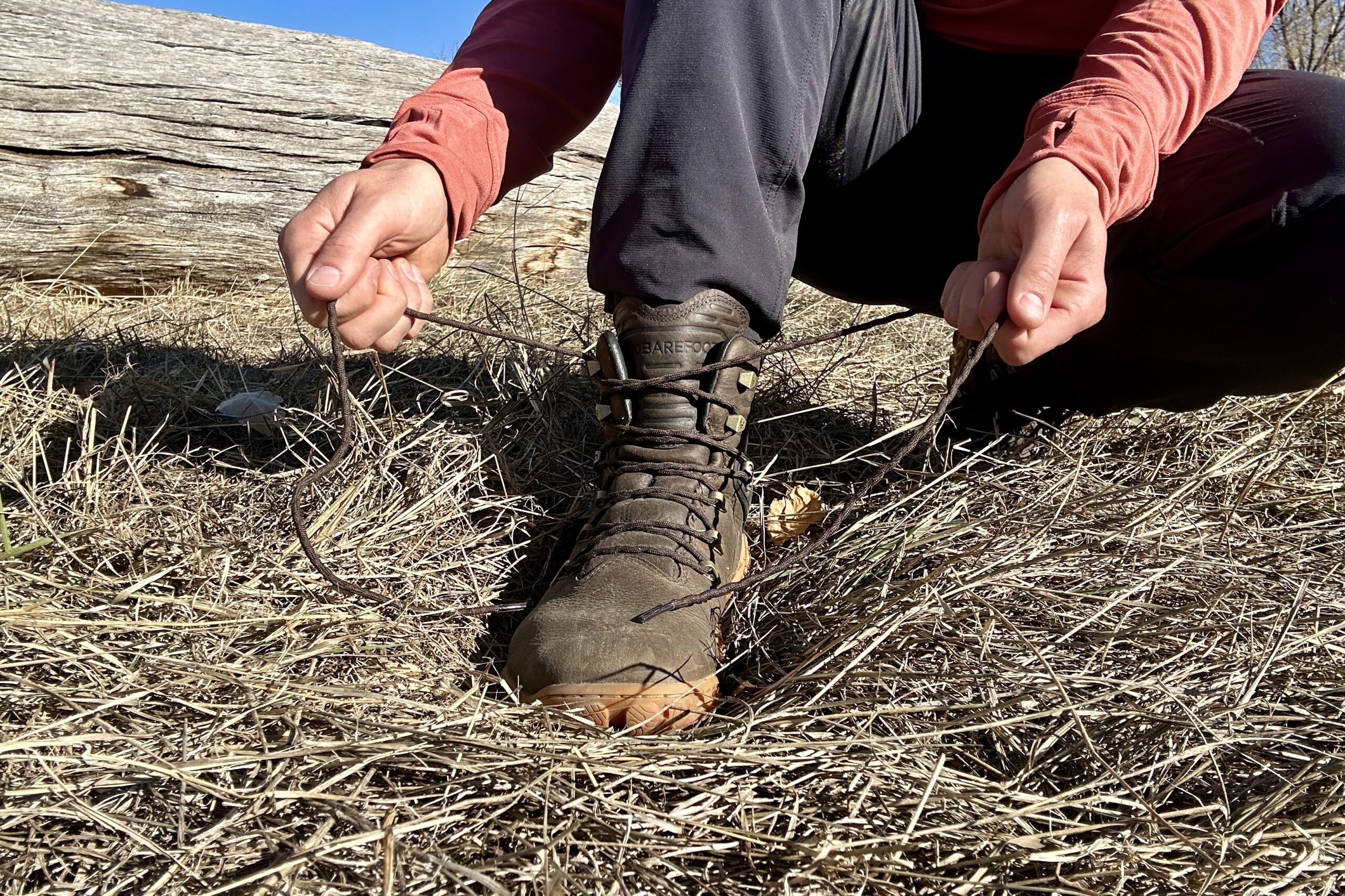
What Different mountaineering boots Ought to You Contemplate?
Head over to our checklist of the Greatest Climbing Boots for Males to take a look at the complete checklist of suggestions. The Vivobarefoot Tracker 2 is the one minimalist choice among the many boots we’ve examined. When you’re not bought on minimalist, zero drop footwear, contemplate a number of the different mountaineering boots we’ve examined and reviewed:
La Sportiva Extremely Raptor II Evaluation – These La Sportivas are on the expensive finish just like the Forest ESC and in addition supply minimal ankle help and distinctive building These boots are additionally a very good wager for moist shoulder season situations the place heat and and traction matter, though they don’t match as ergonomically because the Tracker 2s and have minimal floor really feel.
Salomon X Extremely 4 Mid GTX Evaluation – The Salomon X Extremely 4 Mid GTX are one among our favourite boots for low weight, minimal ankle help, and traction. From winter day hikes to technical trails, these boots are a slam-dunk with ample cushioning, correct sizing, and stellar climate resistance, though in comparison with the Tracker 2s these are extra structured, basic mountaineering boot design with larger price ticket.
Merrell Moab Evaluation – The Moab 3s are some of the standard mountaineering boots of all time due to their consolation and flexibility. Whereas they’ve a better stack top than the Forest ESC, they provide comparable sturdiness and minimalist ankle help. We desire the Moabs for hikes the place floor really feel is much less necessary however you desire a extra comfortable trip – and aren’t as spendy, both.


